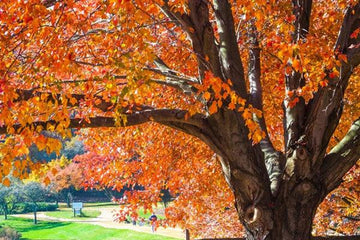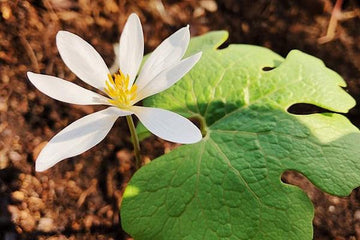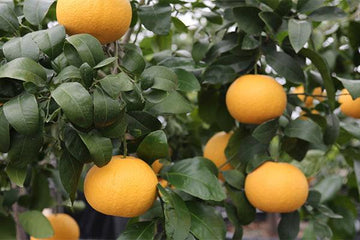How to Plant and Care for Maple Trees, explained
Maple trees offer some of the best shade around. Not only are they relatively fast-growing, but few trees can compete with the fall color of say an October Glory or Brandywine Maple Tree. Maples are disease-free, can tolerate most soil conditions, and grow just about anywhere in the country.
To get the most out of your maple trees, it's essential to get them off to a good start. Proper planting is critical for root development which leads to a healthy canopy.
Ground Rules

LIGHT
Maple Trees prefer to be grown in an area that gets at least 4 hours of sun per day. Maples can be grown in less than the full sun, but they will usually not reach their full potential.

SOIL
Maples prefer average to moist soil and generally will not do well in poorly draining soil. A suitable method for testing your native soil to see if it drains well enough for maples is the following test.
Dig a hole roughly 12 inches wide by 12 inches deep. Fill the hole with water and let it drain completely. Refill the hole with water and time how long it takes for the water to drain from the hole.
If the water drains from the hole in 5 to 15 minutes, the soil is perfect for maples. If it takes over 15 to 30 minutes for the water to drain, the soil isn't ideal for a maple tree, but a maple tree will grow. Anything longer than 30 minutes to an hour is not suitable for a maple tree.

FOOD
Young maple trees benefit from annual fertilization with a balanced fertilizer. If you are concerned about the nutrients in your existing soil, it never hurts to test the soil. Many local extension services offer soil testing. The tests can tell you the Ph of your soil and the existing levels of nutrients that are essential for the healthy growth of shade trees.
When planting your newly purchased maple tree, we recommend Bio-Tone Starter Fertilizer by Espoma. Bio-Tone reduces transplant shock and adds life to the surrounding soil, which helps plants develop healthy and robust root systems.
Each year in the spring, it's recommended to feed the tree with a balanced fertilizer such as Tree-tone. Tree-tone fertilizer is organic, so there's little chance of over-fertilizing and potentially burning the roots of your tree.

TEMPERATURE
Maple Trees can be grown in any part of the United States except for some of the hotter parts of the southwestern US. Maples are very hardy and grow naturally in the northern parts of our country. Maple saplings are often seen growing in fields and woodlands throughout the country.

TOXICITY
While Maple trees are safe for cats, dogs, and humans, Red Maples are toxic to horses and should not be planted in pastures and paddocks where horses are kept.

MULCH
Trees such as maples benefit from a layer of mulch at planting and during the following years. Mulch around the base of the tree inhibits weed growth, helps the planting area retain moisture, and protects the bottom of the tree from being damaged by lawn care equipment.
When mulching, you may be tempted to pile mulch around the base of the tree or trunk. This is doing more harm than good. Mulching too thick can cause the bottom of the tree to develop fungus, which rots the truck and causes the tree to decline as it ages. We also recommend de-mulching or removing the previous year's mulch from the tree before re-mulching.
Planting Process
- Open the box of your tree and carefully remove the plastic bag and ties used to secure your tree in its box.
- Remove the tree from the box and give it a good watering. If possible, place the tree in a shaded area for a day or two to allow it to recover from shipping and acclimate to its new environment.
- Choose a suitable planting area based on the above recommendations.
- Remove the grass from the area where your tree is to be planted and add it to your compost bin or another area of the yard.
- Dig a planting hole twice the width of the pot the tree was grown in. When digging, be sure not to dig the hole any deeper than the soil depth of the potting soil in the pot. It is essential not to plant a tree deeper than the soil is in the pot.****If you're planting in an area that may stay wet after a storm, it's recommended to allow the rootball to stick up above ground level by an inch or two. This helps the root zone of the tree to dry out faster after a storm.
- Amend the soil from the planting hole with peat moss or locally sourced leaf compost at a 50/50 ratio.
- Carefully remove the tree from the pot and place the rootball in the hole. Check to make sure the rootball is level with the undisturbed soil around the planting hole. Begin to backfill in layers tamping each level to remove air pockets.Once the tree is backfilled correctly, use the remaining soil to great a basin around the planting area to allow water to the pond for the first month. This allows the water to slowly seep into the root zone rather than run off as you water. Remove the basin walls after the first 4 to 6 weeks.If you are concerned that you may not water correctly, we recommend Treegator watering Bags. These water bags are specifically designed to provide the perfect amount of water for newly planted trees. Water your new tree 2 to 3 times per week for the first few months and gradually reduce the watering to promote good root growth.
- Mulch with locally sourced mulch being careful not to cover the trunk of the tree. If possible, leave a 2 Inch area of no mulch around the trunk.Note: It is also recommended to stake the tree for the first year. Staking a tree allows it to develop strength and helps the root system establish without the tree rocking back and forth during periods of high wind.
Where to plant maple trees
Choosing the right site for your maple tree is of the utmost importance. Unlike Japanese Maple trees, some maples like sugar maples, for instance, grown as shade trees, can grow up to 75 feet tall, with a canopy spread of 50 feet. Choose an open area of the yard where there is no worry of interfering with power lines. It's also a good idea not to plant larger trees such as maples too close to your home.
Maples are best suited near homes where the canopy can shade your home from the afternoon sun as this will reduce the temperature of the living areas and, in turn, lower your utility bills. Another thing to consider when choosing a site for your tree is that the tree's root system will generally reach as far as the canopy. Keep this in mind so as not to have the tree roots interfere with the foundation of your home or sidewalks.

TYPES OF MAPLE TREES:
| Type: | Height: | Fall Color: | GroZone: |
|---|---|---|---|
| Autumn Blaze | 50 Feet Tall | Red | 3-8 |
| October Glory | 40 Feet Tall | Orange | 3-9 |
| Brandywine | 30 Feet Tall | Burgundy | 4-8 |
| Autumn Flame | 60 Feet Tall | Red | 4-9 |
| Summer Red Maple | 40 Feet Tall | Red | 3-9 |



